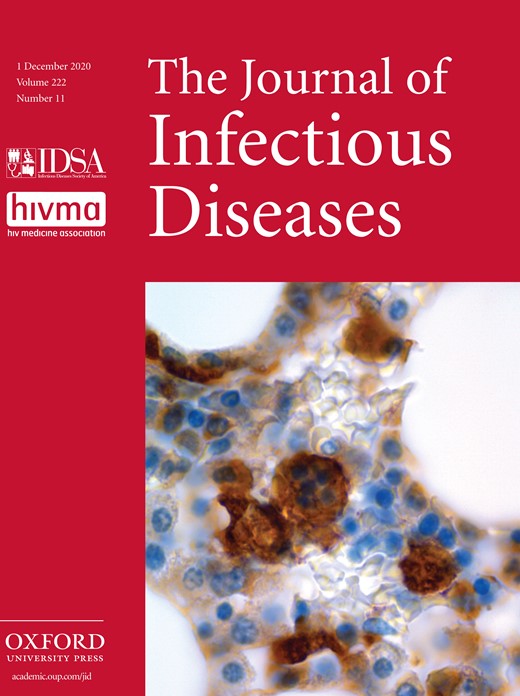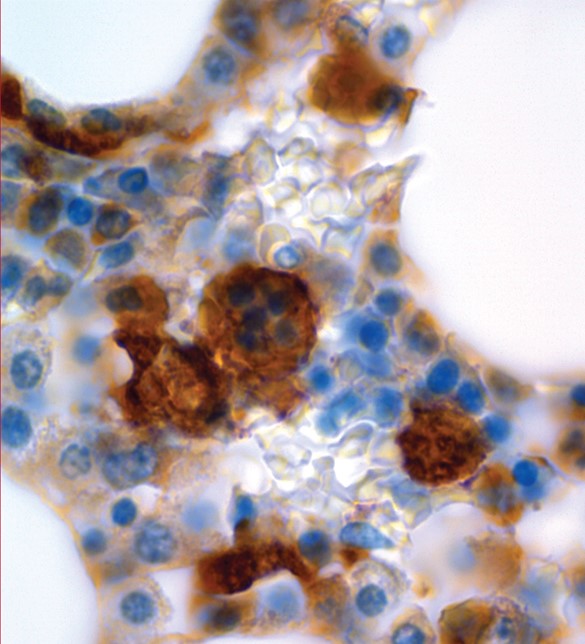
Cover image

Volume 222, Issue 11, 1 December 2020
EDITORIAL COMMENTARIES
Will Severe Acute Respiratory Syndrome Coronavirus 2 Prevention Efforts Affect the Coming Influenza Season in the United States and Northern Hemisphere?
The Goldilocks Zone: Searching for a Phylogenetic Approach for the Recombinogenic Neisseria gonorrhoeae
Wading Into the Morass: Natural Immunity to Enteropathogens
PERSPECTIVE
2019: A Banner Year for Tuberculosis Research
COVID PERSPECTIVE
Are Seroprevalence Estimates for Severe Acute Respiratory Syndrome Coronavirus 2 Biased?
Rationing of Civilian Coronavirus Disease 2019 Vaccines While Supplies Are Limited
Allocation of the initial doses of coronavirus disease 2019 vaccines should account for epidemiology, vaccinology, bioethics, and racial disparities. Our priority tiers for vaccination are critical infrastructure, those at highest medical benefit, and those chosen by a weighted Area-Deprivation Index lottery.
MAJOR ARTICLES AND BRIEF REPORTS
COVID-19
Nonpharmaceutical Interventions Used to Control COVID-19 Reduced Seasonal Influenza Transmission in China
The Issue of Recurrently Positive Patients Who Recovered From COVID-19 According to the Current Discharge Criteria: Investigation of Patients from Multiple Medical Institutions in Wuhan, China
Circulating Endothelial Cells as a Marker of Endothelial Injury in Severe COVID -19
The Fibrosis-4 Index Is Associated With Need for Mechanical Ventilation and 30-Day Mortality in Patients Admitted With Coronavirus Disease 2019
The FIB-4 Index, a simple tool developed to predict hepatic fibrosis, was found to independently be associated with need for mechanical ventilation and 30-day mortality in hospitalized patients with COVID-19.
Environmental and Aerosolized Severe Acute Respiratory Syndrome Coronavirus 2 Among Hospitalized Coronavirus Disease 2019 Patients
In studying 20 hospitalized COVID-19 patients, we found the highest prevalence of severe acute respiratory syndrome coronavirus 2 RNA among patients’ nasopharyngeal and saliva samples (high correlation), but also RNA on fomites and in room air. However, only 2 nasopharyngeal swabs were culture positive.
Postmortem Findings in Italian Patients With COVID-19: A Descriptive Full Autopsy Study of Cases With and Without Comorbidities
Autopsy findings in patients with COVID-19 showed deaths were due to cardiorespiratory failure, predominantly caused by acute lung injury, microvascular damage, and thrombosis. COVID-19 causes multisystem disease and significant pathology in most organs in patients with and without comorbidities.
BACTERIA
Neisseria gonorrhoeae Population Genomics: Use of the Gonococcal Core Genome to Improve Surveillance of Antimicrobial Resistance
Availability of gonococcal whole genome sequence data enhances our understanding of the population biology of this increasingly antimicrobial-resistant human pathogen. Here, genes core to the gonococcus are defined, which can be exploited to track emergence and transmission.
Association of Neisseria gonorrhoeae Plasmids With Distinct Lineages and The Economic Status of Their Country of Origin
Resistance plasmids are widespread in Neisseria gonorrhoeae in less wealthy countries. The presence and type of plasmid are closely associated with the core genome. Our results highlight how the cooperation between plasmids has important implications for the emergence of resistance.
HIV/AIDS
Maintenance of Viral Suppression in Human Immunodeficiency Virus Controllers Despite Waning T-Cell Responses During Antiretroviral Therapy
In a large cohort of human immunodeficiency virus (HIV) controllers (AIDS Clinical Trials A5308), HIV-specific T-cell responses were higher in nonviremic than in viremic controllers. Despite decreasing T-cell responses on antiretroviral therapy, controller status was preserved after therapy was stopped.
Impact of Biological Sex on Immune Activation and Frequency of the Latent HIV Reservoir During Suppressive Antiretroviral Therapy
Cross-sectional analysis of age- and race-matched antiretroviral-suppressed HIV seropositive participants demonstrated no evident sex differences in the frequency of inducible replication-competent HIV or intact HIV DNA within resting CD4 T cells. Marginal sex differences in immune activation markers were observed.
KAWASAKI DISEASE
High-Throughput Screening of Kawasaki Disease Sera for Antiviral Antibodies
High-throughput antibody profiling of acute sera from patients with Kawasaki disease demonstrates no evidence of a shared antibody response to known human viruses.
PATHOGENESIS AND HOST RESPONSE
Protection From Natural Immunity Against Enteric Infections and Etiology-Specific Diarrhea in a Longitudinal Birth Cohort
We estimated natural immunity to enteric pathogens as the effects of previous infections on the incidence of subsequent infections in children under 2. Prior rotavirus, Cryptosporidium, norovirus GII, astrovirus, and Shigella infections were associated with lower risk of subsequent diarrhea.
Trained Immunity Confers Broad-Spectrum Protection Against Bacterial Infections
We used preclinical models to demonstrate that trained immunity confers broad-spectrum protection against bacterial infections. Trained immunity increased myeloid progenitors and circulating inflammatory monocytes and neutrophils, and depletion or neutralization of monocytes/macrophages and interleukin 1 signaling impaired trained immunity-mediated protection.
Inhibition of Necroptosis to Prevent Long-term Cardiac Damage During Pneumococcal Pneumonia and Invasive Disease
The authors demonstrate that Streptococcus pneumoniae kills cardiomyocytes during invasive disease in mice. Cardiac damage was necroptosis dependent and long lasting, possibly explaining adverse cardiac events in convalescent humans. Necroptosis inhibition protected against acute and long-term cardiac damage.
VIRUSES
Remdesivir (GS-5734) Is Efficacious in Cynomolgus Macaques Infected With Marburg Virus
The small molecule remdesivir (GS-5734) showed therapeutic efficacy in a nonhuman primate model of Marburg disease with treatment initiation 5 days post inoculation, supporting further assessment of remdesivir for the treatment of Marburg virus disease in humans.
Cell-Mediated Immunogenicity of Influenza Vaccination in Patients With Cancer Receiving Immune Checkpoint Inhibitors
Flow cytometric analyses revealed that patients with cancer receiving immune checkpoint inhibitors (ICIs) had higher influenza-specific vaccine-elicited cell-mediated immune responses compared with those receiving cytotoxic chemotherapy after seasonal influenza vaccination, which supports annual influenza vaccination in ICI-treated patients.
The Clinical and Economic Burden of Norovirus Gastroenteritis in the United States
We estimate that norovirus costs $10.6 billion annually, based on the latest US incidence estimate. Sporadic community cases represented >90% and productivity losses 89% of the total burden, with more than half the burden in adults aged ≥45 years.
The Use of Next-Generation Sequencing for the Quality Control of Live-Attenuated Polio Vaccines
A high degree of correlation between standard MAPREC test and NGS measurements of 472C nucleotide content in Sabin 3 oral polio vaccines was observed demonstrating that NGS can be used for the batch release of such vaccines.
Directionality of Genital Human Papillomavirus Infection Transmission Within Heterosexual Couples: A Systematic Review and Meta-analysis
There is limited published evidence supporting higher female-to-male than male-to-female human papillomavirus transmission. There is significant heterogeneity among studies; however, future transmission investigations should consider factors such as age and recency of relationships as key variables.



